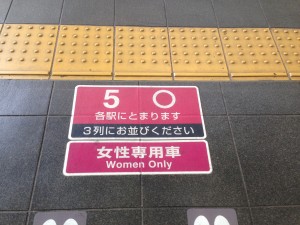
The Eye family is on holiday in Japan at the moment. Our family of four (three male, one female) accidentally jumped into a women’s only carriage on the Osaka metro the other day. It took us one stop to run the gamut of emotions from surprised, to embarrassed, to indignation (that such a carriage was necessary, or at such special treatment for women, take your pick) and we got out and switched carriages at the next stop.
To our surprise, the mixed carriage next door was much less crowded. It appeared that women in that train would rather be in a crowded carriage than one with men in it.
Women’s only carriages have been going longest in Japan (first introduced in 1912), not a country renowned for its feminist outlook on life. Clearly there is scope for a research study into this.
So the questions that occurred to me were:
- What is the difference in crowdedness between women only carriages and mixed carriages?
- Does it vary when the whole subway system is crowded?
- Is there any correlation between the reported rates of sexual harassment in a particular city and the crowdedness of the women’ s only carriages?
- Can we conclude anything about how the dis-utility of sexual harassment relates to the dis-utility of crowdedness? At what point does a woman decide it is better to have to stand without space even to read her iPhone, than to have a seat and the risk of groping?
I leave all these possibilities for anyone looking for a research study (or an excuse for a trip to Japan).
Of course, it is possible that the reason that our women’s only carriage was crowded was just that it was closest to the stairs from the entrance.

And does their existence lead to some unfortunate assumptions – that any woman not using such a carriage must be fair game.
Good point Peter, I completely the neglected the game theory of this in thinking about the statistics.
Some useful Japanese words…
chikan (men who feel up women and girls on packed trains)
Ganguro (alternative fashion trend among young Japanese women that started the mid-1990s, distinguished by a dark tan and contrasting make-up liberally applied by fashionistas).
Ganguro has a connection to Japanese folklore of ghosts and demons who are depicted with a similar appearance such as those in kabuki and noh costumes. This connection is further underlined by the offshoot style…
Yamanba, named after a mountain witch in Japanese folklore.
Thanks, not sure my Japanese is up to using any of these in a sentence!